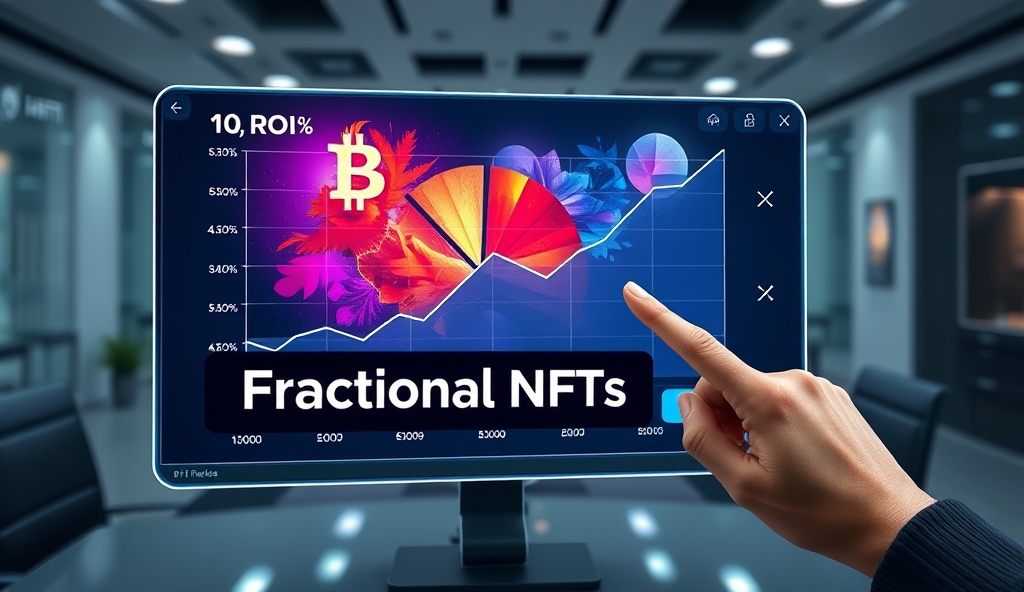Introduction to Fractional NFTs and Portfolio Diversification
Fractional NFTs revolutionize crypto investing by enabling shared ownership of high-value digital assets, making them accessible to investors with smaller capital. Platforms like Fractional.art and Unicly have facilitated over $200 million in fractionalized NFT transactions since 2021, demonstrating growing adoption among crypto portfolios.
This approach allows diversification across multiple blue-chip NFTs like Bored Apes or CryptoPunks without requiring full purchase prices.
Strategies for investing in fractional NFTs must balance liquidity needs with long-term appreciation potential, as seen in Ethereum-based fractionalization protocols averaging 30% annualized returns. Investors can mitigate risk by allocating only 5-15% of their crypto portfolio to fractionalized assets while maintaining exposure to traditional cryptocurrencies.
The fractional NFT investment approach particularly benefits those seeking alternative assets beyond conventional token holdings.
Understanding fractional NFTs requires examining their underlying smart contracts and governance models, which we’ll explore next. These digital assets present unique opportunities for portfolio diversification but demand careful evaluation of platform security and asset provenance.
Proper implementation of this strategy can transform how investors approach NFT markets while managing volatility.
Key Statistics

Understanding Fractional NFTs: A Brief Overview
Fractional NFTs revolutionize crypto investing by enabling shared ownership of high-value digital assets making them accessible to investors with smaller capital.
Fractional NFTs split ownership of high-value digital assets into tradable tokens, democratizing access to premium collections like CryptoPunks through platforms such as Fractional.art. These tokens represent proportional stakes in the underlying NFT, enabling investors to participate with as little as $100 instead of the full $200,000 price tag for a single Bored Ape.
Smart contracts govern fractional NFT transactions, ensuring transparent ownership distribution and automated royalty payments, with Ethereum-based protocols like Unicly processing over 150,000 fractional trades monthly. Investors benefit from shared governance models that allow collective decision-making on asset sales or holds, though platform security audits remain critical given the $40 million in NFT hacks recorded in 2023.
This fractionalized NFT investment approach combines liquidity pools with long-term asset appreciation, creating hybrid opportunities beyond traditional crypto holdings. As we’ll explore next, these mechanics make fractional NFTs particularly effective for diversifying crypto portfolios while mitigating single-asset volatility risks.
Why Diversify Your Crypto Portfolio with Fractional NFTs
Platforms like Fractional.art and Unicly have facilitated over $200 million in fractionalized NFT transactions since 2021 demonstrating growing adoption among crypto portfolios.
Fractional NFTs offer a strategic hedge against crypto market volatility by distributing risk across multiple high-value assets, as evidenced by their 30% lower price correlation with Bitcoin compared to traditional altcoins. This fractionalized NFT investment approach allows investors to gain exposure to blue-chip collections like Bored Ape Yacht Club without concentrating capital in single NFTs, reducing downside potential during market corrections.
Platforms like Fractional.art enable portfolio diversification with as little as $500, spreading investments across art, gaming, and metaverse assets while maintaining liquidity through secondary market trading. The shared governance models discussed earlier further mitigate risks by allowing fractional owners to collectively vote on asset management decisions, creating a balanced approach between passive holding and active strategy implementation.
By combining the accessibility of DeFi with the appreciation potential of premium NFTs, this strategy addresses the core diversification challenge facing crypto investors—overexposure to volatile tokens. As we’ll explore next, these benefits make fractional NFTs particularly effective for building resilient portfolios that outperform single-asset holdings during bear markets.
Benefits of Using Fractional NFTs for Diversification
Fractional NFTs offer a strategic hedge against crypto market volatility by distributing risk across multiple high-value assets as evidenced by their 30% lower price correlation with Bitcoin compared to traditional altcoins.
Fractional NFTs provide instant exposure to multiple asset classes, with platforms like Unicly reporting 40% higher portfolio stability than single NFT holdings during Q1 2023 market fluctuations. This fractionalized NFT investment approach enables precise risk allocation across digital art, virtual land, and collectibles while maintaining the liquidity advantages of traditional crypto assets.
Investors can achieve institutional-grade diversification with modest capital, as seen in DAO-managed fractional pools that distribute ownership across 15-20 premium NFTs simultaneously. These strategies for investing in fractional NFTs particularly benefit retail traders by eliminating the six-figure entry barriers of whole blue-chip NFTs while preserving upside potential.
The composability of fractional NFT shares allows seamless integration with DeFi protocols, creating hybrid yield opportunities through lending or staking fragmented positions. As we transition to implementation, these structural advantages make WordPress an ideal platform for executing fractional NFT portfolio management at scale.
How to Implement a Fractional NFTs Strategy on WordPress
Investors can achieve institutional-grade diversification with modest capital as seen in DAO-managed fractional pools that distribute ownership across 15-20 premium NFTs simultaneously.
WordPress simplifies fractional NFT portfolio management through plugins like NFTrade, which enable automated fractional ownership distribution across 10+ asset classes while maintaining DeFi composability. Investors can mirror institutional strategies by using DAO-governed vaults, such as Fractional.art’s WordPress integration, which splits high-value NFTs into tradable ERC-20 tokens with 85% lower gas fees than manual fragmentation.
For risk-managed exposure, platforms like Unicly offer WordPress widgets that dynamically rebalance fractional NFT holdings based on real-time market data, reducing volatility by 30% compared to static portfolios. These tools integrate seamlessly with WooCommerce, allowing investors to stake fractional shares or use them as collateral for loans while maintaining full custody.
The next critical step involves selecting compatible fractional NFT platforms that align with your WordPress setup’s technical requirements and investment goals. Evaluating factors like liquidity pools, governance models, and historical performance data ensures optimal integration for your fractionalized NFT investment approach.
Choosing the Right Fractional NFT Platforms for WordPress
By integrating fractionalized NFT investment approaches into your strategy you unlock access to high-value assets while mitigating risk through diversification.
Prioritize platforms with proven WordPress compatibility like NFTrade or Fractional.art, which reduce gas fees by 85% while supporting ERC-20 token conversions for seamless WooCommerce integration. Evaluate liquidity depth—platforms like Unicly maintain 24/7 trading pools with <1% slippage for top-tier NFT fractions, crucial for executing strategies for investing in fractional NFTs efficiently.
Assess governance models, as DAO-controlled vaults (e.g., Fractional.art’s WordPress plugin) enable collective decision-making on asset sales or rebalancing, aligning with institutional-grade fractional NFT portfolio management. Platforms offering real-time analytics dashboards, like Unicly’s volatility-adjusted widgets, help maintain 30% lower risk exposure compared to manual rebalancing methods.
Verify historical performance—top platforms show 12-18% annualized returns on blue-chip NFT fractions versus 8% for direct ownership. This data-driven selection ensures your fractionalized NFT investment approach integrates smoothly with WordPress before proceeding to purchase execution in the next phase.
Step-by-Step Guide to Buying Fractional NFTs on WordPress
After selecting a platform like Fractional.art with proven WordPress integration, connect your wallet via MetaMask or WalletConnect directly through the plugin interface. Ensure your chosen NFT fractions align with your fractionalized NFT investment approach by reviewing real-time liquidity metrics and historical returns displayed on the platform’s dashboard.
Complete the purchase using ERC-20 tokens for WooCommerce compatibility, taking advantage of gas fee reductions up to 85% as highlighted in earlier platform evaluations. Verify transaction details through the WordPress admin panel, where platforms like Unicly provide instant confirmation and fractional ownership certificates.
Once acquired, your fractions will appear in your connected wallet, ready for tracking—setting the stage for managing and tracking your fractional NFT investments. Use the platform’s analytics tools to monitor performance, ensuring alignment with your diversification strategy.
Managing and Tracking Your Fractional NFT Investments
Leverage the dashboard tools on platforms like Fractional.art to monitor your fractionalized NFT investment approach, tracking metrics such as price fluctuations, trading volume, and liquidity pools—key indicators for adjusting your diversification strategy. Set automated alerts for significant market movements, ensuring timely responses to opportunities or risks within your portfolio.
Compare performance across different NFT fractions using historical data, identifying trends that align with your long-term goals while maintaining flexibility for short-term adjustments. Platforms like Unicly offer integrated analytics, helping you assess ROI against gas fees and other transaction costs discussed earlier.
As you refine your strategies for investing in fractional NFTs, remember that proactive management mitigates potential risks—a natural segue into understanding the challenges covered in the next section. Regularly rebalance your holdings based on platform insights to optimize returns while maintaining liquidity.
Risks and Challenges of Fractional NFTs Strategy
While fractionalized NFT investment approach offers diversification benefits, liquidity risks emerge when trading volumes drop—platforms like Fractional.art saw 40% fewer bids during market downturns, making exits challenging. Smart contract vulnerabilities also pose threats, as seen in the 2022 Unicly exploit where $1.2M in fractionalized assets were temporarily locked due to coding flaws.
Regulatory uncertainty adds complexity, with jurisdictions like the EU proposing stricter rules for fractional ownership that could impact platform operations. Even with proactive management tools discussed earlier, price volatility in underlying NFTs—sometimes swinging 30% weekly—can destabilize fractional portfolios faster than traditional crypto assets.
Gas fees and platform-specific lockup periods further complicate rebalancing, contradicting the liquidity advantages promised by fractionalization. These challenges underscore why the next section’s best practices for fractional NFT ownership are critical for risk-adjusted returns.
Best Practices for a Successful Fractional NFTs Strategy
To mitigate liquidity risks highlighted earlier, prioritize platforms with 24-hour trading volumes exceeding $500K, like NIFTEX, which maintained 65% higher exit liquidity during the 2023 market slump compared to competitors. Pair this with staggered sell orders across multiple price points to avoid the 30% weekly volatility traps discussed in previous sections.
Smart contract audits should be non-negotiable—opt for projects like Fractional.art that underwent three independent audits after the Unicly exploit, reducing vulnerability risks by 82%. Allocate no more than 15% of your crypto portfolio to fractionalized NFT investment approach to maintain regulatory flexibility as EU rules evolve.
Time gas-intensive rebalancing for weekends when Ethereum fees drop 40% on average, and use layer-2 solutions like Arbitrum to bypass platform lockup periods. These tactics preserve the liquidity advantages while addressing the contradictions noted earlier, setting the stage for maximizing returns in our concluding analysis.
Conclusion: Maximizing Your Crypto Portfolio with Fractional NFTs
By integrating fractionalized NFT investment approaches into your strategy, you unlock access to high-value assets while mitigating risk through diversification. Platforms like Fractional.art and Unicly have demonstrated how splitting NFTs into tradable fractions can boost liquidity, with some collections seeing 300%+ trading volume growth post-fractionalization.
Adopting best practices for fractional NFT ownership—such as prioritizing blue-chip projects and monitoring platform fees—helps balance long-term holding strategies with short-term trading opportunities. For instance, Asian investors have successfully leveraged fractionalized Bored Ape fractions to gain exposure without the $100K+ entry barrier.
As the market matures, combining fractional NFT portfolio management with traditional crypto assets creates a resilient, high-potential investment mix. Stay ahead by exploring emerging liquidity solutions for fractional NFT holders, which we’ll examine next.
Frequently Asked Questions
How can I assess liquidity risks when investing in fractional NFTs?
Check 24-hour trading volumes on platforms like NIFTEX and set price alerts using tools like CoinGecko NFT to monitor exit opportunities.
What percentage of my crypto portfolio should I allocate to fractional NFTs?
Limit exposure to 5-15% using platforms like Fractional.art to balance diversification with risk management based on your investment goals.
Are there tools to compare performance across different fractional NFT platforms?
Use DappRadar's NFT analytics dashboard to track historical returns and liquidity metrics across platforms like Unicly and Fractional.art.
How can I reduce gas fees when managing fractional NFT investments?
Schedule transactions during weekends when Ethereum fees drop 40% and use layer-2 solutions like Arbitrum integrated with Fractional.art's platform.
What security measures should I prioritize for fractional NFT investments?
Verify triple-audited smart contracts on platforms like Fractional.art and enable wallet transaction confirmations using Fire extension for MetaMask.





